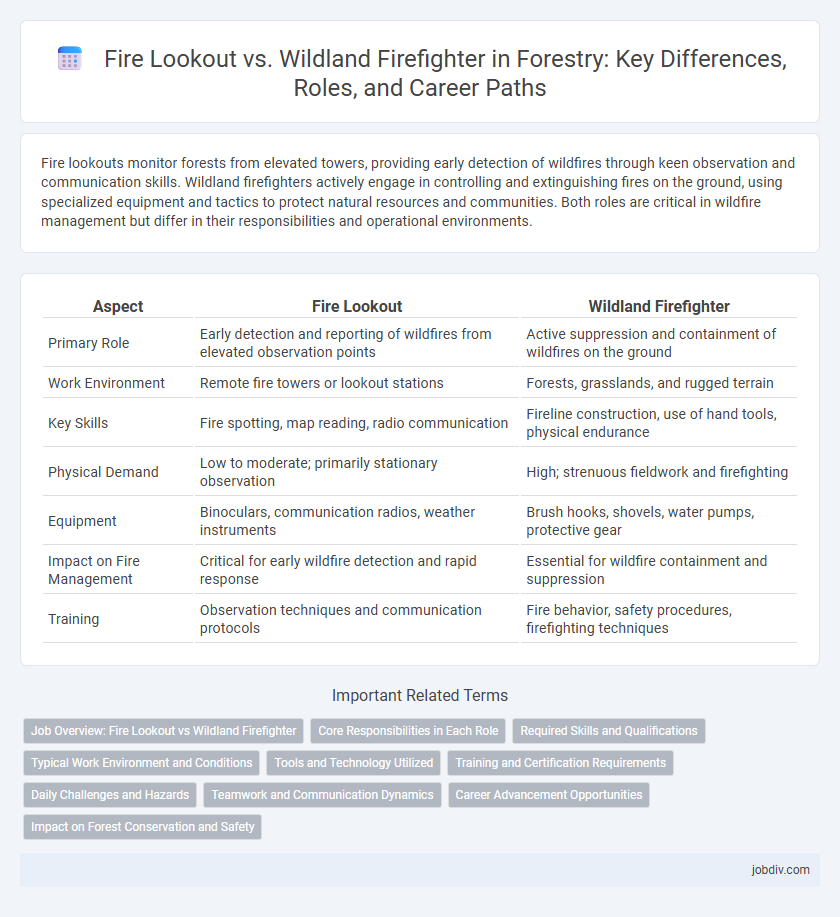Fire lookouts monitor forests from elevated towers, providing early detection of wildfires through keen observation and communication skills. Wildland firefighters actively engage in controlling and extinguishing fires on the ground, using specialized equipment and tactics to protect natural resources and communities. Both roles are critical in wildfire management but differ in their responsibilities and operational environments.
Table of Comparison
| Aspect | Fire Lookout | Wildland Firefighter |
|---|---|---|
| Primary Role | Early detection and reporting of wildfires from elevated observation points | Active suppression and containment of wildfires on the ground |
| Work Environment | Remote fire towers or lookout stations | Forests, grasslands, and rugged terrain |
| Key Skills | Fire spotting, map reading, radio communication | Fireline construction, use of hand tools, physical endurance |
| Physical Demand | Low to moderate; primarily stationary observation | High; strenuous fieldwork and firefighting |
| Equipment | Binoculars, communication radios, weather instruments | Brush hooks, shovels, water pumps, protective gear |
| Impact on Fire Management | Critical for early wildfire detection and rapid response | Essential for wildfire containment and suppression |
| Training | Observation techniques and communication protocols | Fire behavior, safety procedures, firefighting techniques |
Job Overview: Fire Lookout vs Wildland Firefighter
Fire Lookouts vigilantly monitor forested areas from elevated towers or remote locations, using visual observation to detect and report early signs of wildfires, ensuring swift response to prevent major outbreaks. Wildland Firefighters engage directly in wildfire suppression, employing specialized tools and techniques to control and extinguish fires in diverse terrains and environmental conditions. Both roles are critical in wildfire management, with Fire Lookouts emphasizing detection and Wildland Firefighters focusing on active fire containment.
Core Responsibilities in Each Role
Fire Lookouts primarily monitor vast forested areas from elevated towers, detecting smoke or fire signs early to report outbreaks swiftly to firefighting teams. Wildland Firefighters engage directly in fire suppression, using specialized tools and techniques to contain and extinguish wildfires, often working in rugged terrain under hazardous conditions. Both roles are critical to forest fire management, with Lookouts focusing on detection and communication, while Firefighters execute the hands-on containment and control measures.
Required Skills and Qualifications
Fire Lookouts require strong observational skills, attention to detail, and the ability to identify smoke or fire patterns from elevated vantage points, often without immediate supervision. Wildland Firefighters need physical endurance, knowledge of fire behavior, and proficiency in using firefighting tools and tactics to safely contain and extinguish wildfires. Both roles demand effective communication skills and a commitment to safety protocols, but Wildland Firefighters typically undergo rigorous physical training and certification in wildfire management.
Typical Work Environment and Conditions
Fire lookouts operate from remote, elevated towers or isolated stations, often enduring long hours of solitude and exposure to varying weather conditions to spot smoke and alert crews quickly. Wildland firefighters work directly on the ground in rugged forests, grasslands, or mountainous terrain, facing physically demanding tasks, intense heat, smoke, and unpredictable fire behavior. Both roles require adaptability to harsh outdoor environments but differ significantly in proximity to active fire zones and physical exertion levels.
Tools and Technology Utilized
Fire lookouts primarily utilize high-powered binoculars, automated weather stations, and communication radios to detect and report smoke or fire conditions from elevated vantage points. Wildland firefighters rely on a range of specialized tools including drip torches for controlled burns, chainsaws for clearing vegetation, GPS devices for navigation, and advanced fire behavior modeling software to strategize containment efforts. Both roles increasingly incorporate drone technology and satellite imagery to enhance situational awareness and improve wildfire response accuracy.
Training and Certification Requirements
Fire lookouts typically undergo basic training in fire detection techniques, map reading, and emergency communication, often requiring certification in wildfire spotting and radio operation. Wildland firefighters must complete extensive training programs such as the National Wildfire Coordinating Group (NWCG) courses, including Incident Command System (ICS) certifications, fire behavior, safety protocols, and physical fitness standards. Certification for wildland firefighters is more rigorous, with mandatory field qualifications like the Red Card, ensuring readiness for active fire suppression and complex incident management.
Daily Challenges and Hazards
Fire Lookouts face isolation and extreme weather while maintaining constant vigilance to detect early signs of wildfire, relying heavily on visual acuity and communication technology. Wildland Firefighters encounter physical exhaustion, unpredictable fire behavior, and hazardous terrain during active suppression efforts, requiring rapid decision-making and teamwork under intense stress. Both roles demand acute awareness of environmental risks, but Firefighters confront immediate life-threatening dangers frequently, whereas Lookouts manage prolonged mental strain and exposure to the elements.
Teamwork and Communication Dynamics
Fire lookouts and wildland firefighters maintain critical teamwork and communication dynamics essential for effective wildfire management. Fire lookouts provide real-time, high-ground surveillance, transmitting precise location data and fire behavior observations that guide wildland firefighter strategies on the ground. This continuous information exchange ensures coordinated efforts in containment, enhances situational awareness, and improves safety in challenging wildfire environments.
Career Advancement Opportunities
Fire Lookouts primarily focus on early fire detection and reporting, offering limited career advancement beyond supervisory roles in fire monitoring stations. Wildland Firefighters have diverse pathways for career growth, including advanced firefighting tactics, specialized training, and leadership positions such as Fire Captain, Incident Commander, and fire management officers. Skills acquired as a Wildland Firefighter, such as incident management and emergency response coordination, significantly enhance prospects for promotions and roles in federal or state forestry agencies.
Impact on Forest Conservation and Safety
Fire lookouts provide early detection of wildfires, enabling rapid response that significantly reduces forest damage and improves safety for both ecosystems and nearby communities. Wildland firefighters actively suppress and manage fires, directly protecting forest resources and minimizing the spread of destructive flames. Together, their roles are critical in maintaining forest conservation and ensuring human safety during fire events.
Fire Lookout vs Wildland Firefighter Infographic

 jobdiv.com
jobdiv.com